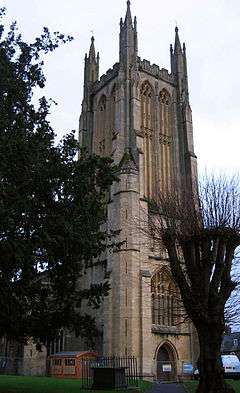St Cuthbert's Church, Wells
The Church of St Cuthbert is an Anglican parish church in Wells, Somerset, England, dating from the 13th century. It is often mistaken for the cathedral. It has a fine Somerset stone tower and a superb carved roof. It is a Grade I listed building.[1]
| Church of St Cuthbert | |
|---|---|
 | |
 Location within Somerset | |
| General information | |
| Location | Wells, Somerset |
| Address | St Cuthbert St |
| Coordinates | 51.2083°N 2.6503°W |
| Construction started | 13th century |
| Completed | 15th century |
| Height | 142 feet (43 m) |
History
The dedication of the church to St Cuthbert suggests Saxon origins.[2] Originally an Early English building (13th century), from which the arcade pillars survive,[2] it was much altered in the Perpendicular Period (15th century),[3] when the clerestory and angel roof were added to the 7-bay aisled nave.[2]
It is built of Doulting ashlar stone to most of the south side. The north side is ruble with ashlar dressings. The north transept (St Catherine's Chapel) has the remains of its 13th century reredos on the east wall, which was rediscovered in 1848. The south transept which is otherwise known as The Lady Chapel has another stone reredos dating from 1470, based on the Tree of Jesse theme.[1]
Until 1561 the church had a central tower which either collapsed or was removed, as a result of alterations to the structure and decoration of the church in line with the changes in theological and liturgical practice during the Protestant Reformation.[4] It has been replaced with the current tower over the west door.[5] Bells were cast for the tower by Roger Purdy.[6] The present tower, the third highest in Somerset, at 142 feet (43 m) high,[7] is of 3 stages, with the top stage occupying half the total height.[1]
The nave's coloured ceiling was repainted in 1963 at the instigation of the then Vicar's wife, Mrs Barnett.[1][8] During the restoration works in the 1960s a 15th-century carved and panelled ceiling was found above the side chapel which had been covered with plaster during the 18th or 19th centuries.[9]
There is a carved wood pulpit of 1636, with an elaborate stair and two carved coats of arms, of Charles I, and Charles II.
Organ
The church contains a pipe organ originally by Henry Lincoln dating from 1820. It was rebuilt by William Sweetland of Bath in 1864, George Osmond of Taunton in 1959 and Percy Daniel in 1984. A specification of the organ can be found on the National Pipe Organ Register.[10]
Filming location
The church played an important role in the feature film Hot Fuzz, which was filmed largely in Wells (which became the fictional town of Sandford); most notably the church fete scene where Adam Buxton's character is dramatically killed by a falling part of the church tower masonry. In the early 1970s a lightning strike caused a pinnacle to fall through the nave roof, which may have inspired the scene.
Parishes
- Wells St Cuthbert In
- Wells St Cuthbert Out
References
| Wikimedia Commons has media related to Category:Church of St Cuthbert, Wells. |
- "Church of St Cuthbert". historicengland.org.uk. Retrieved 2006-08-24.
- Bush, Robin (1994). Somerset: The complete guide. Wimborne, Dorset: Dovecote Press. pp. 223. ISBN 1-874336-26-1.
- Leete-Hodge, Lornie (1985). Curiosities of Somerset. Bodmin: Bossiney Books. p. 20. ISBN 0-906456-98-3.
- Dunning, Robert (1996). Fifty Somerset Churches. Somerset Books. pp. 90–94. ISBN 978-0861833092.
- "Our Church". St Cuthbert, Wells. Retrieved 2008-03-05.
- "Bells in St Cuthberts Tower, Wells, Somerset". Notes & Queries. s2-IV(93): 284–285. 1857. doi:10.1093/nq/s2-IV.93.284-b.
- Wickham, Archdale Kenneth (1965). Churches of Somerset. London: David & Charles.
- "Nos.14-27 Vicars Close". historicengland.org.uk. Retrieved 2006-08-24.
- Byford, Enid (1987). Somerset Curiosities. Dovecote Press. p. 38. ISBN 0946159483.
- "NPOR N18293". National Pipe Organ Register. British Institute of Organ Studies. Retrieved 14 September 2015.